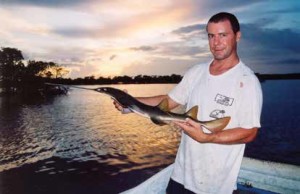A RARE ENCOUNTER WITH A RARE FISH
Rookery Bay National Estuarine Research Reserve staff were conducting a nonbreeding bird route survey recently in the Ten Thousand Islands near Cape Romano, and were very excited to observe a 30-inch smalltooth sawfish. At this size, the sawfish would be considered “youngof-the-year” and was most certainly pupped in Reserve waters. They were able to watch the sawfish from a distance of just a few feet as it casually swam in a small mudflat pool in just four inches of water, likely attracted by the large number of bait fish that were also observed.
“This was a rare encounter, and a first observation of a smalltooth sawfish in its habitat for me, personally,” said Reserve research coordinator Kevin Cunniff. Smalltooth sawfish, closely related to sharks and rays, historically inhabited coastal and estuarine waters from North Carolina to Texas. However, as their numbers have been drastically reduced from habitat loss and commercial fishing impacts (as by-catch from becoming entangled in fishing nets), southwest Florida is their last stronghold. The smalltooth sawfish was classified as endangered in 2003 under the federal Endangered Species Act (ESA) and is now fully protected. The ESA designates smalltooth sawfish Critical Habitat that includes the waters of Florida Bay, Rookery Bay Reserve and the Estero Bay/Caloosahatchee River/Charlotte Harbor complex.
 According to Cunniff, research on these fish is in its infancy, and not a great deal is currently known about the habits and life history of this species. Smalltooth sawfish can grow to lengths of 18 to 25 feet, attain a weight close to 800 pounds, and perhaps live for 25 – 30 years.
According to Cunniff, research on these fish is in its infancy, and not a great deal is currently known about the habits and life history of this species. Smalltooth sawfish can grow to lengths of 18 to 25 feet, attain a weight close to 800 pounds, and perhaps live for 25 – 30 years.
Reserve waters serve as critically important habitat for adult fish and pupping and nursery habitat for juvenile fish. Smalltooth sawfish forage for fish and crustaceans over mangrove-lined, shallow muddy or sandy bottom, while preferring the moderate salinity ranges characteristic of the estuary.
Over the past 15 years, Reserve research staff have been gathering data on smalltooth sawfish caught and tagged in the Ten Thousand Islands as part of a long-term research program assessing juvenile shark status and trends. This information has proven to be very important for supporting the wider effort to better understand this species so that we can collectively be able to better manage resources and ensure the continued survival of this rare and ancient fish.
Learn more about shark and sawfish monitoring in the reserve at www.rookerybay.org.
Rookery Bay National Estuarine Research Reserve protects 110,000 acres of coastal lands and waters between Naples and Everglades National Park. It is managed by the Department of Environmental Protection’s Florida Coastal Office in cooperation with the National Oceanic and Atmospheric Administration, and serves as an outdoor classroom and laboratory for students and scientists from around the world.


Leave a Reply
Want to join the discussion?Feel free to contribute!